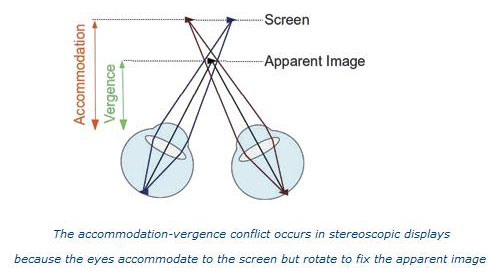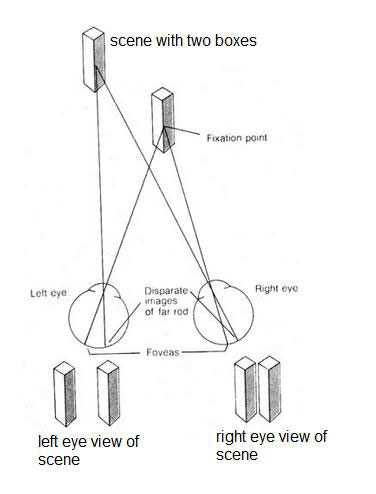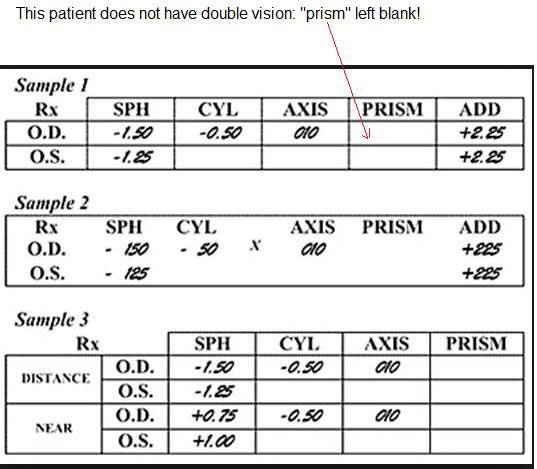
|
By itself, this isn’t enough to start a quarrel between our eyes and 3D movies; the ciliary muscles can simply accommodate for the fixed screen location. Unfortunately for 3D movies, ciliary muscles aren’t the only muscles that participate in giving us a three dimensional view of the world. When we fix our gaze on an object in space, the muscles that move the eyeballs (extraocular muscles) rotate the eyes in opposite directions to make the lines of sight of the two eyes intersect at the location of the object (fixation). So when the yellow jacket flies closer to our face, our eyes cross and when it moves away our eyes un-cross. This instinctive response is known as “vergence.” The accommodation and vergence responses are well coordinated so that the point where the lines of sight of our eyes intersect is also the point where our eyes focus. In a 3D illusion this coordination between the two muscle types is disrupted, because the extraocular muscles want to verge on where the object appears to be, while the ciliary muscles want to stay focused on the screen. This conflict, many believe, is the main source of discomfort in 3D movies (see Figure 1).

Image Source: sidmembers.org |
I should add, though, that unlike my friend who gets dizzy, some folks’ problem with 3D movies is double vision. Double vision happens because a frame of 3D film is actually two views of the same scene taken from different angles. In fact, this is exactly how having two eyes (binocular vision) gives us the ability to see the world in 3D. Since the eyes are separated by a distance (interpupillary distance), each eye gets its view of the scene from a different angle (see figure 2). The closer the object, the bigger the difference in the respective angles of view. The optics of 3D movie glasses make sure the left eye receives only the view angle meant for the left eye and the right eye receives only the view angle meant for the right eye. Our brain will then sort out a depth map of the scene based on the view angles of each eye provided the views are imaged on the correct location in each eye (retinal correspondence). If the two views don’t fall on the right locations in each eye, instead of a single view with 3D depth we experience two separate images. How do our eyes normally achieve the correct retinal correspondence? By making sure that their lines of sight intersect at the location of the object being viewed, in other words vergence. And as we saw above, in 3D movies the vergence response is sometimes disrupted. Hence the double vision.

|
[Insert where appropriate pull quote: The optics of 3D movie glasses make sure the left eye receives only the view angle meant for the left eye and the right eye receives only the view angle meant for the right eye.]
The condition where the lines of sight of the eyes fail to intersect at the point of focus can occur outside the 3D theater. It is known as “binocular diplopia” and is corrected with eyeglasses that bend the incoming light just enough to achieve retinal correspondence between the eyes. Since prisms bend light, adding the right amount of prism to the eyeglasses accomplishes this fix. The often blank “prism” box in eyeglass prescriptions has to do with correcting for vergence dysfunction problems that cause diplopia (see figure 3).

|
3D display in relation to the functioning of the human eye is an active area of research beyond just the entertainment industry’s concern to eliminate the occasional headache and dizziness. The medical field is increasingly finding uses for 3D technology for performing microsurgery, creating a high-end demand for improved displays. Aptly, it turns out that the requirements of ophthalmic surgery have put ophthalmics at the forefront in adapting this technology.

|










